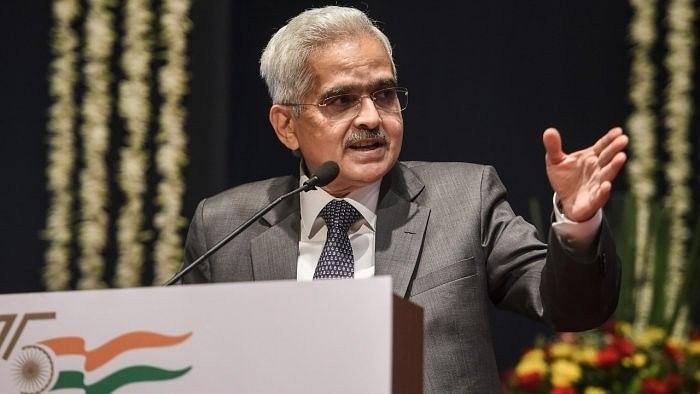
RBI Governor Shaktikanta Das.
Credit: PTI File Photo
Monetary Policy Committee of the Reserve Bank of India (RBI) on Thursday unanimously decided to keep policy repo rate unchanged at 6.5 per cent for the third time in a row but revised retail inflation projection for the current fiscal to 5.4 per cent from its earlier estimate of 5.1 per cent, citing upturn in food inflation and uncertainties in global crude oil prices.
The central bank’s rate setting panel also decided by a majority of five out of six members to remain focused on “withdrawal of accommodation” to ensure that inflation progressively aligns with the target, while supporting growth, RBI Governor Shaktikanta Das said.
MPC member Jayanth R Varma expressed reservations on the resolution related to “withdrawal of accommodation”. Other members Shashanka Bhide, Ashima Goyal, Rajiv Ranjan, Michael Debabrata Patra and Governor Shaktikanta Das voted to remain focused on withdrawal of accommodation.
Consequent to the pause on repo rate, other key policy rates also remain unchanged. The standing deposit facility (SDF) rate remains unchanged at 6.25 per cent and the marginal standing facility (MSF) rate and the Bank Rate at 6.75 per cent.
Interest rates on home, car and other loans are governed by the RBI’s policy rates. As the central bank has decided to keep the key policy rates unchanged the EMIs on home, car and other loans would also remain unchanged.
Citing recent spike in food inflation and uncertainties in global crude oil price and possible El Niño conditions in August and beyond, the RBI has revised its projection for Consumer Price Index (CPI) inflation for 2023-24 to 5.4 per cent. In the second quarter of the current financial year CPI inflation is projected to accelerate to 6.2 per cent. It is projected to remain at 5.7 per cent in Q3 and at 5.2 per cent in Q4. In the first quarter of 2024-25, CPI inflation is projected at 5.2 per cent.
CPI-based inflation, which the RBI monitors for its policy action, rose to 4.81 per cent in June after hitting a 25-month low of 4.25 per cent in May. It is projected to hit around 6 per cent in July.
“The month of July has witnessed accentuation of food inflation, primarily on account of vegetables. The spike in tomato prices and further increase in prices of cereals and pulses have contributed to this,” RBI Governor said.
Consequently, a substantial increase in headline inflation would occur in the near-term, he added.
“The MPC has delivered in line with market expectations on rates, stance and tone, with retention of rates and stance and the tone turning hawkish,” said V K Vijayakumar, Chief Investment Strategist at Geojit Financial Services.
With the increase in inflation projection, the RBI has signalled that the “policy rates will remain high for long and, therefore, a rate cut can be expected only in Q1 FY25,” he said. “From the market perspective, there are no positive or negative surprises in the policy,” Vijayakumar added.
The RBI has retained its GDP growth projection for the current fiscal at 6.5 per cent. In the first quarter of the current fiscal GDP growth is pegged at 8 per cent. It is likely to fall to 6.5 per cent in the second quarter and ease further to 6 per cent in Q3 and 5.7 per cent in Q4. Real GDP growth for Q1 of 2024-25 is projected at 6.6 per cent.
“We have made good progress in sustaining India’s growth momentum. While inflation has moderated, the job is still not done,” RBI Governor said, indicating hawkish stand on curbing inflation.
“Inflationary risks persist amidst volatile international food and energy prices, lingering geopolitical tensions and weather related uncertainties,” he added.
RBI prefers to be in “wait and watch” mode to check if the recent food price inflation is getting generalised and prefers to keep rates on hold and keep the monetary policy unchanged, said Deepak Agrawal, CIO- Fixed Income, Kotak Mahindra Asset Management Company.